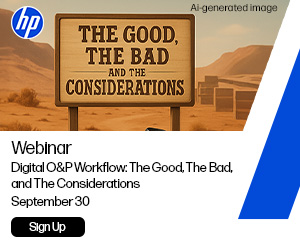3d printed scaffolds
BellaSeno’s Clinical Trial on 3D-Printed Breast Implants Shows Promising Early Results
Bioprinting firm BellaSeno has provided a public update on its ongoing clinical trial for resorbable breast scaffolding. The trial uses patients’ own fat with a 3D-printed scaffold, which gradually reabsorbs…
BellaSeno’s Pioneering 3D Printing Facility for Medical Implants to Open in 2025
German 3D printing medical implant pioneer BellaSeno plans to launch a fully automated production facility in Australia by mid-2025 to make its resorbable soft tissue and bone reconstruction implants. By…
BellaSeno Receives European Authorization for 3D Printed Bone and Chest Wall Implants
Founded in 2015, German medtech company BellaSeno GmbH develops novel resorbable 3D printed soft tissue and bone reconstruction implants, and last summer announced two clinical trials for its 3D printed…
Coral Reefs Restoration Pursued with Binder Jet 3D Printing
According to the US Environmental Protection Agency (EPA), 25% of all marine life is dependent upon the biodiverse underwater ecosystems known as coral reefs. Unfortunately, as coral reef conservation organization…
3D Printing News Briefs, May 2, 2021: Intech; 3DPrinterOS & Octoprint; BEAMIT; ITB, ITK, & University of Manchester; Makerbot; Satori & Oxford University
We’re going to take care of business first in today’s 3D Printing News Briefs, and then move on to some research and education. Intech Additive Solutions is reporting multiple orders…
3D Printing News Briefs, December 17, 2020: TRIANKLE, EnvisionTEC & Henkel, Siemens Energy
In today’s 3D Printing News Briefs, an international research consortium of organizations is working to develop 3D bioprinted ankle implants. EnvisionTEC and Henkel are partnering to combine 3D printing and…
4-Axis 3D Printing Enables Tubular Implants with Controllable Mechanical Properties
Disease and other trauma can cause hollow, tubular human tissues, like the trachea, intestine, bone, and blood vessels, to be negatively affected by long-segmental defects. Autologous grafts can help fix…
Magnesium Phosphate Aid Bone Regeneration for 3D Printed Implants
International researchers continue the trend toward overcoming challenges in bone regeneration, sharing the results of their study in the recently published “Tough magnesium phosphate-based 3D-printed implants induce bone regeneration in…
Antibacterial Properties & Cytocompatibility of EPL in 3D Printed Composite Scaffolds
Chinese researchers continue to study 3D printing materials and structures, releasing their findings in the recently published ‘Study on antibacterial properties and cytocompatibility of EPL coated 3D printed PCL/HA composite…
3D Printing Geopolymer Filters for Water Treatment Systems
Researchers from Italy and Finland are focused on improving ways to deliver clean drinking water, detailing their study in the recently published ‘Ag- or Cu-modified geopolymer filters for water treatment…
3D Printing: Successful Scaffolds in Bone Regeneration
In ‘Comprehensive Review on Full Bone Regeneration through 3D Printing Approaches,’ the authors review new developments and solutions in tissue engineering for the formation of cells, as well as proposing…
China: Bioprinting Polycaprolactone/Silk Fibroin Scaffolds to Improve Meniscus Regeneration
Researchers from China are hoping to improve medical outcomes for patients dealing with knee joint issues. Their recent study, ‘Biomechanically, structurally and functionally meticulously tailored polycaprolactone/silk fibroin scaffold for meniscus…
China: 3D Printed Drug Delivery Scaffolds, Evaluated in Rat Femoral Bones
Chinese researchers are working to improve drug delivery systems for bone repair, detailing their findings in the recently released ‘A novel vehicle-like drug delivery 3D printing scaffold and its applications…
Tissue Engineering for Bone Regeneration: 3D Printing of Piezoelectric Barium Titanate-Hydroxyapatite Scaffolds
German researchers continue in the quest to improve processes in bioprinting and bone regeneration, sharing their recent study in ‘3D Printing of Piezoelectric Barium Titanate-Hydroxyapatite Scaffolds with Interconnected Porosity for…
3D Printing & Electrospinning Multi-Layer PCL-PGS Scaffolds with Bioactive Glasses
Sometimes, when researching tissue engineering, scientists must combine different fabrication methods and materials to build scaffolds that meet multiple requirements at once – mimic native tissue’s mechanical response, have biocompatibility,…
University of Manchester: Improved Cell Alignment with 3D Printed & Electrospun PCL Scaffolds
UK researchers from the University of Manchester are experimenting with 3D printing techniques for bioprinting, with their findings recently published in ‘Three-Dimensional Printing and Electrospinning Dual-Scale Polycaprolactone Scaffolds with Low-Density…
Denmark: 3D Printing Conductive Hydrogels for Medical Applications
In the recently published ‘Electrically Conducting Hydrogels for Health care: Concept, Fabrication Methods, and Applications,’ Shweta Agarwala of the Department of Engineering at Aarhus University in Denmark researchers 3D printing…
Shanghai Jiao Tong University School of Medicine: 3D Printing Scaffolds for Tendon-to-Bone Interface Engineering
Researchers from China’s Shanghai Jiao Tong University School of Medicine are exploring complex developments in tissue engineering, releasing their findings in the recently published ‘Three-dimensional printed multiphasic scaffolds with stratified…
3D Printed Haversian Bone: Biomimicking for Cell Regeneration
Chinese researchers continue to take on the challenge of bone regeneration in tissue engineering, sharing their findings in the recently released ‘3D printing of Haversian bone—mimicking scaffolds for multicellular delivery…
Cartilage Tissue Engineering via Characterization and Application of Carboxymethyl Chitosan-Based Bioink
International researchers continue the trend in exploring natural biomaterials for bioprinting, detailing their findings in the recently published ‘Characterization and Application of Carboxymethyl Chitosan-Based Bioink in Cartilage Tissue Engineering.’ Examining…
3D Printing Scaffolds for Regeneration of Tissue After Mastectomies & Tissue Damage
Researchers from Belgium and Germany explore topics in bioprinting, evaluating biocompatible structures in the recently published ‘Evaluation of 3D Printed Gelatin-Based Scaffolds with Varying Pore Size for MSC-Based Adipose Tissue…
Freeze-FRESH 3D Printing: Biomaterial Scaffolds with Hierarchical Porosity
Researchers Zi Wang and Stephen J. Florczyk of the University of Central Florida have developed a new technique for bioprinting, outlined in the recently published ‘Freeze-FRESH: A 3D Printing Technique…
Italy: Studying Properties & Geometry of Scaffold-Like Structures for Tissue Engineering
Italian authors Claudia Pagano, Lara Rebaioli, Francesco Baldi, and Irene Fassi explore the unique details of creating scaffold-like structures in the recently published ‘Mechanical behavior of scaffold-like structures: Research of…
Tissue Engineering & Bioprinting for Success in Hydrogel Microenvironments Today
In the recently published ‘Engineered 3D Polymer and Hydrogel Microenvironments for Cell Culture Applications,’ authors Daniel Fan, Urs Staufer, and Angelo Accardo explore the world of bioengineering and microenvironments, reviewing…















